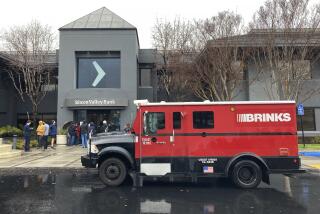Southland Must Live With Static Water Supply, State Report Says
Central and Southern California must give up plans to increase water imports from the northern part of the state and should reduce imports to 1985 levels to improve San Francisco Bay’s fisheries, state water officials said Thursday.
At the same time, Southern California must tailor its water rights to better suit the environment, as should other entities currently uninvolved in the water-quality debates--notably utilities with hydroelectric dams in the Sierra.
That is the thrust of a draft report from the state Water Resources Control Board on water quality in San Francisco Bay and the Sacramento-San Joaquin Delta, the source of 40% of the state’s drinking water.
The report, six months overdue, is the first sign of how broadly the board will try to alter the rights to two-thirds of all water used in the state. The reconsideration was ordered in a landmark 1985 state appellate court case that threatened to radically reshape California’s water picture.
The goals can be met, staff members said, with strict, permanent and widespread conservation--a new “California water ethic.” That ethic calls for the use of conservation, reclamation and other measures so that everyone can “reasonably share in the use of California’s water supply.”
Southland water officials said they generally were shocked and disappointed by the recommendations, while Northern California environmentalists expressed surprise and subdued delight.
“We could be talking about a drought every year--forever,” said Richard Atwater, of the giant Metropolitan Water District. He said the rapidly growing agency, which directly or indirectly serves most of urban Southern California, now uses twice as much delta water as it did in 1985; the delta makes up more than half the district’s anticipated supply for next year.
“Their approach in putting all the emphasis on getting cities and farmers to use less--to conserve--as the panacea is just totally unrealistic,” Atwater said. “We believe in strong protection for the fish and wildlife, but we just don’t see the balance” between human and environmental needs.
William Davoren of the Bay Institute of San Francisco, an environmental group that has long lobbied for strict environmental standards for the bay, cautiously noted that the report is merely a staff recommendation, but acknowledged its significance.
“It looks like the water quality control board . . . has some long overdue good news for fish and wildlife,” he said. “The board may yet be able to preserve the natural spawning of striped bass and salmon--if they follow the recommendations of these professional scientists and biologists.”
“I suspect everybody with an interest in this is going to be dissatisfied to some extent,” said Walt Pettit, chief of the water rights division for the Water Resources Control Board. “To that, I can only say we tried to balance all of the various interests.”
Basically, the water board staff concluded that current water exports hurt Northern California’s fishing industry and recommended that an additional 1.5 million acre-feet of water flow to the ocean in the spring to help more young fish survive.
The water would come from better managing San Joaquin River tributaries and reducing exports to Central California farms and Southern California cities by 670,000 acre-feet between April and July, the report said. At the same time, staffers suggested increasing exports by an identical amount in the wet fall and winter months.
In the end, the report recommends limiting exports to 5.5 million acre-feet a year, the amount siphoned off in 1985. The report said that amount is “the highest to date and 16% higher than the average” over the last 10 years, but Atwater of the MWD disputed that.
In any case, the report concluded that plans to boost exports to 6 million or 7 million acre-feet should be shelved.
“The 5.5 million acre-feet in exports will remain the same; that amount is fixed,” said Gerald Johns, assistant chief of the board’s water rights division. “All we’re doing is shifting when it is taken.”
An acre-foot is the amount needed to cover an acre of land a foot deep. It is about 325,800 gallons, the annual consumption of two urban families or a quarter of an acre of alfalfa. Farms use more than 80% of the state’s water.
If Southern California wants to grow beyond its current water supplies, it apparently will have to find water elsewhere; in the past, suggestions have included conservation, transfers from farms and buying water rights from other states bordering the Colorado River.
The new report, however, clearly favors conservation over any of those ideas. It estimated that Southern California could continue to add 400,000 residents a year and still not markedly increase its water needs if only it would start conserving more vigorously.
“It’s a rather ambitious target,” Atwater noted wryly.
The staff report, if it is approved by the water board after public hearings early next year and then withstands the almost inevitable legal challenges, would set the stage for future hearings to determine exactly how its recommendations should be met.
Issuance of the report marked the end of the first part of a three-phase, quasi-judicial process to rethink how California uses water. The goal is to balance San Francisco Bay’s own benefits with those of using its water elsewhere. The process could continue into the mid-1990s, water officials said Thursday.
Southern California is not the only area affected by the report’s ideas.
Metropolitan San Francisco, for example, was told that it should stop dumping waste into the bay and not wait for the state to allocate huge volumes of fresh delta river water to flush the toxins out to the sea.
More to Read
Start your day right
Sign up for Essential California for news, features and recommendations from the L.A. Times and beyond in your inbox six days a week.
You may occasionally receive promotional content from the Los Angeles Times.





